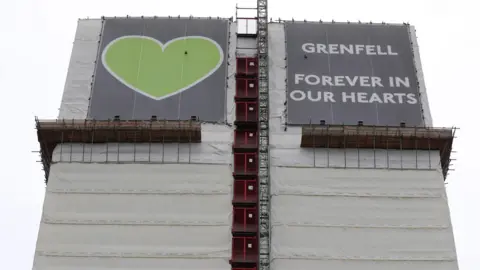Up to £3bn may be needed to fix building cladding
 PA Media
PA MediaUp to £3bn of public money may have to be spent assessing and removing potentially flammable cladding from buildings in Scotland.
New estimates from the Scottish government suggest up to 1,450 residential buildings may need remediation work, including about 250 high-rises.
It was previously estimated about 900 buildings were affected.
However, full surveys will be needed to establish what needs to be done on a case-by-case basis, with 107 buildings being examined as part of a pilot phase.
It is now estimated that the Cladding Remediation Programme could cost £1.7bn to £3.1bn over a 15-year period.
If new legislation is passed by the Scottish Parliament, additional funding could be unlocked to fix building safety issues.
The Building Safety Levy (Scotland) Bill will see a tax charged on the construction of certain new residential properties, in line with equivalent legislation in England.
The bill seeks to raise about £30m a year to help fund work to fix residential buildings with unsafe cladding which have no linked developer.
Public Finance Minister Ivan McKee said: "The Scottish government is committed to doing what is right and necessary to address the challenge of fixing buildings affected by unsafe cladding.
"That includes putting the appropriate funding arrangements in place to ensure that the associated costs of cladding remediation do not fall directly onto affected homeowners.
"I know that developers share our determination to keep people safe and this levy will ensure they make a fair contribution to these costs, just as they will be doing in England."
He added: "I also welcome the continued co-operation of developers who have accepted responsibility for the assessments and any required mitigation and remediation of their buildings."
 PA Media
PA MediaTrade body Homes for Scotland, whose members deliver the vast majority of all new homes in Scotland, said they were committed to remedial action on buildings they had built.
But a spokesperson raised concerns about the impact of a building safety levy.
"In addition to the proposed Building Safety Levy, Scotland's largest home builders are already contributing to the remediation of other impacted buildings through their payment of the Residential Property Development Tax (RPDT)," they said.
The spokesperson said the proposed levy would mean an additional layer of taxation which "will add thousands of pounds to the cost of new homes, pushing families, first-time buyers and future generations further away from home ownership".
They added: "At a time when Scotland is facing a housing emergency and 693,000 Scottish households are living in some form of housing need, this is simply unacceptable."
Grenfell Tower fire
The UK government agreed in principle to devolve the powers needed for a Scottish Building Safety Levy last year.
Last month ministers announced plans to speed up efforts to inspect and repair buildings in response to the 2017 Grenfell Tower fire in London that killed 72 people.
The 23-storey tower's cladding is believed to have contributed to the rapid spread of the fire.
It broke out in the kitchen of a fourth-floor flat at the tower block in North Kensington, just before 01:00 on 14 June 2017.
Within minutes, the fire had rapidly spread up the exterior of the building and moved across all four sides. By 03:00, most of the upper floors were well alight.
As well as those killed, more than 70 people were injured.
The Cladding Remediation Programme was set up in the aftermath of the disaster but Scottish ministers have been criticised for its slow progress.
